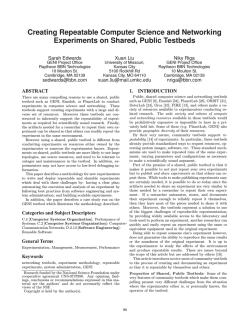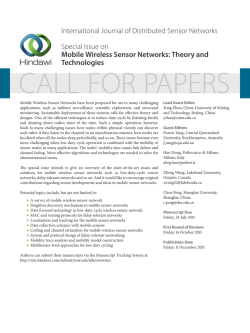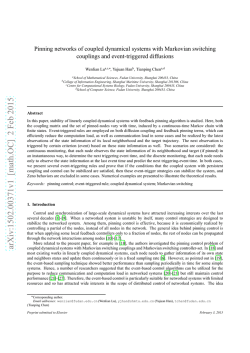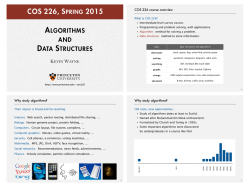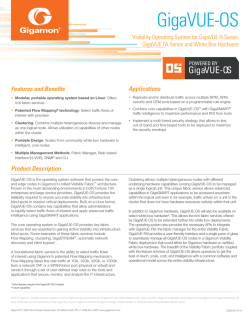
A community finding method for weighted dynamic online social
1 A community finding method for weighted dynamic online social network based on user behavior Dongming Chen1, Yanlin Dong1, Xinyu Huang1, Haiyan Chen2, Dongqi Wang1* 1. Software College, Northeastern University, Shenyang, 110819, China 2. East China University of Political Science and Law, Shanghai, 200000, China Abstract—Revealing the structural features of social networks is vitally important to both scientific research and practice, and the explosive growth of online social networks in recent years has brought us dramatic advances to understand social structures. Here we proposed a community detection approach based on user interaction behavior in weighted dynamic online social networks. We researched interaction behaviors of users in online social networks and built a directed and un-weighted network model in terms of the following relationships between social individuals at the very beginning. In order to refine the interaction behavior of users, level one fuzzy comprehensive evaluation model was employed to describe how closely individuals are connected to each other. According to this intimate degree description, weights are tagged to the prior un-weighted model we built. Secondly, a heuristic community detection algorithm for dynamic network was provided based on the improved version of modularity called module density. As for the heuristic rule, we chose greedy strategy and fed the algorithms with the update part between two neighboring time slices’ network model. A parameter β was also set to evaluate the impacts of individuals’ joining and leaving actions in directed networks. Experimental results show that the proposed algorithm can obtain high accuracy and simultaneously get comparatively lower time complexity than some typical algorithms. More importantly, our algorithm needs no priori conditions. Index Terms — Complex Network, Community Structure, Modularity, Dynamic Network, Directed and Weighted Network I. INTRODUCTION Research of complex networks has a wide attraction of scientific research. Some scholars focus on semantic network[1] which means a form of human knowledge relationships [2][3], and some other researchers obtain algorithms for community detection, which is a fundamental problem in network analysis. Detecting communities is of great importance in sociology, biology and computer science, disciplines where systems are often represented as graphs. This problem is so complex that Dongming Chen (e-mail: [email protected]). Yanlin Dong (email: [email protected]) Xinyu Huang (email: [email protected]) Haiyan Chen (email: [email protected]) *Dongqi Wang (corresponding author; phone: +86 13624039571; email: [email protected]) we didn’t find a satisfied solution by far, despite the huge effort of a large interdisciplinary community of scientists working on it over the past few years [4]. Traditional methods treat community detection as graph partitioning and clustering problems. Kernighan-Lin(KL) algorithm[5] is an early proposed graph partitioning based method, which uses greedy strategy to optimize the divided structure according to the edges between communities, the evaluation function is defined as the number of edges in the two communities minus the number of edges connecting them. KL algorithm can divide target network into specific size subsets, but the number of subsets is needed as a priori. As KL algorithm, the majority of graph partitioning methods require too much prior knowledge, and most variants of the graph partitioning problem are NP-hard. More importantly, the partitioning results are usually consisted of clusters with similar size. Taking all these shortcomings into consideration, graph partitioning algorithms are not fully suitable for detecting communities in big social networks [6]. Unlike graph partitioning methods, clustering do not need much prior knowledge, so clustering based methods can be more effective for community detection. For example, hierarchical clustering algorithms are known as suitable approaches to be used to detect communities in social networks. Social networks naturally have hierarchical structures, which mean networks with hierarchical structure may display several levels of grouping of the nodes. Small clusters are contained within large ones, which are in turn included in larger ones, and so on [7]. Some clustering algorithms try to divide a target network naturally into many parts based on the similarity and intensity of each node, and these works can be classified into two kinds: aggregation algorithms and divisive algorithms. For example, the Newman fast algorithm [8] is a typical aggregation method based on greedy strategy, mainly focuses on the network with numerous vertices. Typical divisive algorithm is as method [9], which treats the network as a huge community, and then divides it step by step. The GN algorithm proposed by Girvan and Newman [10] is another example of divisive method. The main idea is to remove the edges with maximal betweenness [11], which provides a rule of edge detection for the small community in the network. Except for traditional methods, community detection in weighted, directed or dynamic networks is also widely discussed separately. Few works took these features together into consideration, and comparing to the research on unweighted and undirected networks, no significant achievements had been made. Most networks in real world can 2 be seen as heterogeneous ones because the nodes have different characteristics and the relationship between two nodes usually means different influences to them. In fact, heterogeneity of nodes can be represented in weighted, directed network models. On the other hand, dynamic network analysis had drawn a lot of attentions in the past few years. As we know, a dynamic community detection method was firstly proposed by Hopcroft [12], it divided the dynamic network into several static parts, then obtained the hierarchy clustering results with the method of cosine similarity. They selected relatively slightly changed parts from the results as natural communities, and dynamic network evolution was studied on the above bases. Chakrabarti [13] tried to analyze dynamic network via continuous iteration, the concepts called snapshot quality and history cost were proposed in this work to satisfy both “clustering results should keep pace with the current network topology as far as possible” and “the results should minimize the difference between the clustering process”. In order to understand the dynamic of social network structure, Shan build a mathematical model [14], and an incremental identification method is also proposed, which analyzes the nodes incrementally rather than just to re-divide all nodes in the network, to improve actual operation efficiency of the algorithm. Ning’s work is also a valuable attempt [15], they put forward the incidence vector concept to present the dynamic process of the network through incrementally updated characteristic value system. Chen, Wang and Wei approach a novel multiobjective algorithm for detecting communities in dynamic networks, which provides a solution to keep a balance between accuracy and efficiency [16]. In Yu’s work, a feasible algorithm for the identification of overlapping modules in PPI networks is proposed, which detects communities with more flexibility [17]. As we can see, excellent research works had been done on community structure detection, however, the existing algorithms either need too much priori knowledge or not good enough to handle complex network models. The research on weighted, directed and dynamic networks may provide us more ways to understand real networks. And designing fast and reliable network community detection algorithms will continue to be the attractive area for us in the future. On the other hand, with regards to community detection methods, quality functions are very important, because an algorithm needs a stopping criterion. Nowadays, the most commonly known function is called network modularity [18], which represents one of the first attempts to achieve a first principle understanding of the clustering problem, and it embeds in its compact form all essential ingredients and questions, from the definition of community, to the choice of a null model, to the expression of the strength of communities and partitions[4]. Because of this, we are going to employ modularity in this paper to evaluate the division results and we take online social network as our target network, a detailed analysis on the dynamic process of how an online social network evolves will be shown. The rest of this paper is organized as follows. Section 2 we build a weighted social network based on interaction behavior analysis of online social network. Section 3 gives a community detection algorithm for dynamic directed weighted networks. Section 4 compares our method with well-known algorithms through experiments. Finally, Section 5 makes the conclusions. II. SOCIAL NETWORK WEIGHTED METHOD BASED ON USER INTERACTION BEHAVIOR RESEARCH When studying network structure, we first focus on the interactions between individuals and define an approach to weight the edges to involve more online social network information into our network model. We assume edge weights represent the interaction intensity between nodes, which will reflect both the existing parameters in physical world and calculating features defined by ourselves. The calculating features will reveal the underlying characteristics of online social networks. For a network containing complex social relationships such as similarity and intimacy, we try to transform one or more of the interactive attributes to be weights, to measure the intimacy between users. The method employed a weight with fuzzy synthetic evaluation model according to the interaction of followers and the frequency of interaction over a period of time. The theoretical basis of weighting method is fuzzy comprehensive evaluation method[19], which transforms qualitative evaluation to quantitative evaluation according to the fuzzy membership degree theory. For short, it is a method to provide an overall evaluation to objects which are restricted by multiple factors with fuzzy comprehensive evaluation on multiple factors [20]. In dynamic online social networks, such as Facebook[21] and microblog [22], the behaviors, for example, 'comment', 'forward', 'like', 'at' can reflect the proximity between users during a period of time. In our comprehensive evaluation method, we select the level one comprehensive evaluation model [23] as the method to measure the relationship. Here we assume B as the collection of user behaviors: B = {comment, forward, like, at} It is crucial to allocate the weight for the above factors. The weights of the behaviors are confirmed by statistical methods. The data used in the paper comes from NLP laboratory of Beijing Institute of Technology which collects data of Sina microblogs in recent two years [22]. The dataset contains 1.5 million users and 50 million microblogs. There are 86,341,256 interaction behaviors, including 21,510,466 'comments', 36,538,478 'like', 23,299,712 'forward' and 4,992,600 'at'. So we can easily figure out the proportion shown as the following vector A and the member of A is the proportion of each kind of interactions. A = (0.2491, 0.4232, 0.2699, 0.0578) Then we assume a 4 n evaluation matrix R for a single factor, which is formulated as follows. r1n r11 r12 r r r2 n Rx 21 22 r31 r32 r3n r4 n r41 r42 Here n represents total number of users x followed, r1n denotes how many times user x did 'comment' action. r2n represents how many times user x did 'forward' action, r3n 3 represents how many times user x did 'like' action, r4n denotes how many times user x did 'at' action, n|x represents user n was followed by user x. User x’s behavior and connection relationship with other users are shown in Table 1. Table 1 Evaluation of user x’s behaviors Followed Behaviors followed_id1 Comment Forward Like At r11 r12 r13 r14 Matrix R for user x can be calculated as follow: commentnum(n | x) (1) r1n n commentnum(i | x) forwardednum(n | x) (2) n forwardednum(i | x) likenum(n | x) followed_idn r21 r22 r23 r24 … … … … r1n r2n r3n r4n 0.875 i 1 r3n … We can calculate the evaluation matrix R003 of node 003, for example, the user did ‘at’ behavior to others for eight times during a period of time, particularly ‘at’ user 032 for seven times. So we can get the following data. atnum(032 | 003) r4(032|003) atnum(009 | 003) atnum(023| 003) atnum(032 | 003) i 1 r2 n followed_id2 If we calculate all the data according to the above (3) method, we can get the matrix as follows. n likenum(i | x) i 1 r4 n atnum(n | x) (4) R003 n atnum(i | x) i 1 Where commentnum(n|x) counts how many times user x 'comment' user n, and forwardednum(n|x) counts how many times user x 'forward' n’s articles, likenmu(n|x) counts how many times user x set 'like' tag to user n’s articles and atnum(n|x) counts how many times user x did 'at' actions to user n when they post their own articles or comments. Then we explain the evaluation model with following Figure 1, which is generated from nodes of sina microblog. We take user 003 as an example, detailed information can be discovered in table 2. 0.1667 0.0714 0.1290 0.1250 0 0.1429 0.1613 0 0.8333 0.7857 0.7097 0.8750 Finally, we can get the Level I comprehensive evaluation model B003. B003 A R003' 0.2491 0.4232 0.2699 0.0578 0 0.8333 0.1667 0.0714 0.1429 0.7857 0.1290 0.1613 0.7097 0 0.8750 0.1250 0.1138 0.1040 0.7822 The result represents the weight value of ‘at’ behavior from user 003 to the three neighboring users are 0.1138, 0.1040, 0.7822. III. COMMUNITY PARTITION ALGORITHM FOR DYNAMIC DIRECTED WEIGHTED NETWORKS Figure 1 The network of test example. User_id 003 003 003 Table 2 Statistics of user 003 Comment Transmit Attention_id num num 009 1 1 025 0 2 032 5 11 Like num 4 5 22 At num 1 0 7 This paper proposed an algorithm which needs no priori conditions, the algorithm firstly set up heuristic rules of the dynamic changes of the social network based on the basic nature of community structure, and employed an improved module density function D combined with weighted network, to ensure the accuracy of the algorithm [24]. We give some basic definitions which will be used in the rest part. For directed weighted network G w (V , E ,W ) , where V is the collection of nodes inside Gw, E is the collection of edges inside Gw, eij E is an edge from node i to node j, W is the 4 collection of weights of Gw’s edges and edge wij is the weight of eij , we define: (1) The in-weight and out-weight of nodes in the network. The symbol wini represents the sum of all edges weights i ending with node i, and wout denotes the sum of all edges weights starting with node i. (2) The inside-edge weight and outside-edge weight in the community. Symbol Win (ci ) means the total weight of edges inside a community, Wout (ci ) discloses the total weight of edges outside a community, which are shown in formula (5) and formula (6). An edge inside a community means that both of the two ends of the edge fall into the community. (5) Win(c ) w i i , jci Wout (ci ) ij ici , jci (6) wij 2 ic1 , jc2 community c1 and c 2 where c1 and c 2 are two collections of disjointed nodes or two communities who have no overlapping parts between them. The second function also has two variants as shown in formula (8), (8) L(i, c ) w i jci ij where i represents a node. Function L counts neighbors of node i inside community ci or the increased number of nodes ci when new node i is added into the community. Furthermore, Lin (i, ci ) counts the number of edges from node i to community ci , where Lout (i, ci ) inside community discloses the number of edges from community ci to node i. wd (4) D (ci ) formulates module density of community ci , it can be calculated by formula (9). Win (ci ) Wout (ci ) (9) 2n Here n is the number of the nodes of the network. Then we define D wd , which means the increased D wd ci module density when a node i is added into community ' ci to constitute a new community ci , it can be calculated by formula (10). D wd Dtwd Dtwd n n1 (10) is an out-degree edge for node i, then the importance of the node i to the community is 1, otherwise, it is (0 <1) . For a node of a community, an in-degree edge has more influence on the community than an out-degree edge. Now we assume the situation of node i joining into community ci to form a ' ij L calculate the sum weights of edges in community direction is from node j to node i, then only marginal influence is impressed on the whole community and we can ignore it. So in the paper, we use a parameter (0 <1) to represent the weight of in-degree. It means a node i waiting to join community ci , connected with a directed edge. If the edge new community ci . As shown in formula (11) and (12), (3) Function L in directed weighted networks. Function L is a polymorphism function with two variants for directed and weighted networks. As shown in formula (7). (7) L(c , c ) w 1 In order to deal with the affection of direction factor in the network, we can assume a node i with high out-degree and low in-degree, while node j is on the contrary. Obviously, if there is an edge between node i and node j, the direction of the edge is most possibly from node i to node j. Similarly, if there is an edge from node i to node j, the module density that of the community will be greatly influenced, which means that node i prefers to be a member of community ci . Instead, if the t Wint (ci ) calculates Win (ci ) of time t, and Wout (ci ) calculates Wout (ci ) of time t. Wint 1 (ci ) Wint (ci ) Ltin (i, ci ) Ltout (i, ci ) t 1 out W (11) (ci ) W (ci ) ( 1) L (i, ci ) t out t in (12) i ( 1) Ltout (i, ci ) ( wini wout ) So we can calculate the module density following formula (13). To make the structure of the new community ci' more reasonable, we calculate the increased module density D wd as follows. W Win 3 Lin 3Lout d in d out (13) D wd out 2n where n represents the number of nodes of the network. Formula (13) gives the evaluation rule, which is also the key of the algorithm in this paper. Most of the algorithms are based on greedy strategy or approximation algorithm, to improve the efficiency of calculation. In our daily life, we can easily find that if a person is my friend, he or she will most probably be my friend’s friend. So we prefer to set the node i to be a member of the original community. Thus, we put forward the principle combining with heuristic greedy strategy: for any node i in the network, we prefer to put it into community which contains the most neighbors of node i. It has two key points: greedy selection property and optimal substructure. Our algorithm deals with directed and weighted networks. However, for a real network, it is almost impossible for the degree of all nodes to be even. Then, the structure of the network is an undirected and unlooped graph with a corresponding matroid. The greedy strategy is one of the situations of the matroid, so the idea based on module density with greedy strategy is reasonable. There are mainly 4 kinds of reasons that will cause the dynamic variety of real networks. We can conclude them as follows: 5 (1) Adding a node (V+v): When a new node is joined in the network, it is likely to connect other edges or not. (2) Deleting a node (V-v): When a node is deleted, then all of the edges connected with this node are also removed. (3) Adding an edge (E+e): Connect two nodes in the network to produce a new edge. (4) Deleting an edge (E-e): Remove an edge between two nodes. A dynamic community changes its structure in accordance with the above four situations, and in most cases the first and the third situations are often occurred, while the second and the fourth situations are very scarce. A. Analysis of community structure variations The four changing situations of a dynamic community result in the structure of community evolving, too. In the network we confronted in real life, there are only six cases when a community structure changes. (1) Community generation: new nodes are added to a network dynamically, and these nodes may form a new community as shown in Figure 2(a). (2) Community extinction: nodes of a community are removed gradually, and finally the community disappeared as shown in Figure 2(b). (3) Community expansion: the community will expand when many new nodes or edges are joined as shown in Figure 2(c). (4) Community decrease: the community will decrease with the removing of part of nodes or edges and it makes the community smaller and smaller as shown in Figure 2(d). (5) Community combination: two communities are merged into one community dynamically as shown in Figure 2(e). (6) Community split: a community is split into two or more communities dynamically as shown in Figure 2(f). It can be easily proved that the changing results are among the above six situations. Null Null (a) (b) B. Algorithm description We analyze the four possible dynamic behaviors and design the algorithm as follows. (1) Adding a node: When the new node has no connection with any other nodes, it will be a new independent community. If the new node has connection with other nodes, we put the node into the community which can get the highest gain in module density. The pseudo code of the algorithm is designed as follows. ( c t denotes the community structure at time t) Algorithm 1 AddNode Input: the structure of a community at time t, and a new node v awaiting to be added Output: the updated structure at time t+1 // d v is the degree of node v. If (d v 0) then Update c t 1 c t {v} Else For existing communities, put v into each of them Do Calculate D wd End For c=get the maximal D wd when node v joins in the community Update c t 1 (ct \ c) (c {v}) (2) Deleting a node: If the degree of the removed node is 1, just delete the edge connected to the node, otherwise, delete all the edges connected to the node and reassign the neighbor nodes of the deleted node to the community which can achieve a higher module density. If the connected edges are all within the community, just keep the neighbor node in the original community. The pseudo code of deleting a node is given as follows. Algorithm 2 DeleteNode Input: the structure of a community at time t, and the removed node v Output: the updated structure at time t+1 k=1; If (node v’s degree is 1) c t 1 c t \ c (c \ v ) {v} Else (c) (e) (d) (f) Figure 2 The six changes of a community While (Node v’s neighbor is not 0) do S {nodes who doesn’t have connections with nodes outside c } End while End if Put the nodes in S into the considered best community which has the maximal D wd Update c t 1 (3) Adding an edge: when the new node i and node j belong to the same community ( ci c j ), the new edge from i to j can enhance the value of function D according to the definition of module density. So the inside edge will not break 6 up the original community. However, if the two nodes i and j are not in the same community ( ci c j ), then the new edge eij calculate betweenness value for each edge. If the intermediate value of the removed edge eij is comparatively large, we will is an outside edge, it will decrease the module density of the community comparatively. Thus, the new edge may not change the structure of the community, or make one node in ci or cj break away from the original community and join another community so as to obtain higher module density. When a new edge eij joined into network, we assume re-divide the community when removing the edge, otherwise, just keep the original community structure unchanged. The algorithm is designed as follows: X ci ,Y c j to judge if the new edge will increase the module density for community Y. The algorithm is designed as wd wd follows, where Dixy and Dixy are the gain of module Algorithm 4 DeleteEdge Input: the structure of community at time t and the removed edge eij Output: the updated structure at time t+1 If ( eij is a single edge) then c t 1 ( c t \ i{ j, } ) i { } j { } density when putting node i and j into X and Y. Else if (the degree of either i or j is 1) then Algorithm 3 AddEdge Input: the structure of community at time t, and the new edge eij. Output: the updated structure at time t+1 If (node i and node j are new nodes) then Update c t 1 c t {i, j} Else if ( ci c j ) then wd If ( Dixy ) <0 & D wd jxy<0 Update ct 1 ct Else wd wd Node v = Dixy >D jxy?i : j Move v to the new community For all neighbors of v Put it into the best community which has the maximal ∆Dwd End for t 1 Update c End if End if End if c t 1 ( c t \c (j ) ) i { } c i{ i( ) \ } Else if (node i and node j don't belong to the same community) then ct 1 ct Else Int z = Get the betweenness of eij If (z is the top n biggest betweenness of the network) Put other nodes into the considered best community which holds the maximal D wd End if End if Update c t 1 Then we analyze the time complexity of every step in the algorithm. 1) Initialization. Initialize N nodes and at most N communities, which takes the time complexity of O( N ) . 2) Iteration. Iterations are taken place for k times, and to each iteration, the maximal L(i, ci ) are sought for all of the N nodes. For node i, the (4) Deleting an edge: when the nodes i and j of an edge come from different communities (ci c j ) , removing the edge weakens the linkage of intercommunity. Removing an outside edge makes a higher module density, so it will keep the original community structure. When the two nodes(i and j) of the removed edge belong to the same community (ci c j ) , if the degree of node i or node j is 1, then one of the two nodes will be isolated node after removing the edge. The node will separate from the original community, and the new separate community will contain only one node. If the node degree of both i and j are 1, then two new isolated communities emerged. When the two nodes (i and j) of the removed edge come from different communities (ci c j ) , and the node degree is different from above, the removing of the outside edge eij results a lower module density. Then the original structure either keeps unchanged or divides into two communities. Thus, we get the idea from GN algorithm [15], which regards the community (ci c j ) as a small network, then d (i) neighbors are assigned to N N communities, so there are at most d (i) times satisfied i 1 L(i, ci ) 0 for each iteration. So it takes time complexity of N O(k d (i )) for searching maximal L(i, ci ) . It must be i 1 estimated for each iteration to make sure if the constraint condition is satisfied or not for all of the nodes, which takes time complexity of O(kN ) . 3) Modification. Algorithm 1 to algorithm 3(described in section III) are simple linear calculation on given variables, which takes time complexity O(kN ) , linear calculation on neighbors of every variable brings complexity N O(k d (i )) . i 1 7 The total time complexity is N community evolution. It also conforms to the objective rule of ‘Rich get Richer’. N O( N k d (i ) kN kN k d (i )) , which is i 1 i 1 simplified as O ( kN k N d (i)) . Assume that the edge i 1 N number of the network is E, then d (i) 2E , so the final i 1 In reality, the iteration time will be acceptable for most networks, so the algorithm will be efficient. Especially, the more obvious of the community structure will be, the less iteration time will be needed, and the more efficient will the algorithm be. However, if the community structure is not clear, the community detection algorithm will make no sense all the same. time complexity is O(kN kE ) . From the reckon above, we can get the time complexity of the algorithm is O(kN kE ) , N denotes the number of nodes and E represents edges in the network, and the k is the number of iteration. Consequently, the value of k is vital in running the algorithm. From the time complexity proved above, we can conclude that the consuming time of the algorithm will decrease with the decline of k value. So, the smaller the k value becomes and the faster the algorithm runs. According to the Heuristic principles of basic property in community structure, the algorithm will need to detect a community from the node with more neighbor nodes as possible. Obviously, the more nodes a community contains, the more suitable for algorithm to detecting, which enable the main community become greater during the dynamic Table 3 dataset size IV. EXPERIMENT AND ANALYSIS In this section, we carry out the experiments by using Sina microblog dataset with 5,000 users. And we establish four networks with 100, 500, 1000 and 5000 nodes respectively. To show the results conveniently, we choose some representative nodes to build a small network. Then we compare the efforts with other algorithms. Firstly, to confirm the value of , we do the experiment with different network scale(dataset size). When the experiments end, we choose the value of when the community obtains the maximum value of module density. The results are shown in Table 3. Relation between and module density 0.40 0.45 0.50 0.55 0.60 0.65 0.70 0.75 0.80 S100 0.399 0.420 0.442 0.459 0.467 0.471 0.456 0.433 0.384 S500 0.435 0.473 0.494 0.509 0.522 0.519 0.498 0.492 0.478 S1000 0.511 0.537 0.554 0.568 0.577 0.585 0.575 0.560 0.542 S5000 0.553 0.592 0.627 0.658 0.683 0.697 0.680 0.657 0.621 From Table 3, we can conclude that in most cases when the value of is 0.65, the module density will reach the maximal value. Thus, we choose the approximate value of 0.65 for the rest experiments. Comparing with extremal optimization algorithm [25] and improved CNM algorithm [26], we do experiments to get the time overhead and the module density. The comparison results are listed in Table 4 and Table 5. Table 4 Time Overhead comparison of different algorithms dataset size S100 S500 S1000 algorithms Our algorithm Extremal optimization Improved CNM algorithm algorithms 0.285 0.317 0.279 1.962 2.231 2.195 7.450 7.983 7.964 Table 5 Modularity comparison of different algorithms dataset size S100 S500 S1000 Our algorithm Extremal optimization Improved CNM algorithm 0.369 0.362 0.347 From Table 4 and Table 5, we can conclude that the algorithm in this paper outperforms in time consuming compared with extreme optimization and improved CNM algorithm as an increasing in network scale [26]. 0.433 0.405 0.398 0.527 0.485 0.451 S5000 105.317 132.250 125.725 S5000 0.573 0.510 0.494 To demonstrate the high quality of the divided results, we can evaluate the module density of the algorithms. Figure 3 shows the changing tendency of module density when network scale increases, which discloses the larger of the network scale, 8 the bigger of the module density will be. Module density reflects the divisive quality of network, so the proposed algorithm is suitable for large scale network. Module Density Module Density 0.8 0.6 0.4 0.2 0 0 5 10 time (s) 15 value of module density S100 value of module density S500 value of module density S1000 value of module density S5000 Figure 3 Changing Tendency of Module Density The above experiments have presented the results in static networks. So we randomly add four behaviors of dynamic network variations (described in section 3) to compare with the other algorithms. The adjustment of the community is based on increments of the network and it is locally conducted, even in the most complex situations, the time expenses of the algorithm can be neglected, and the results are shown in Figure 4. for online social networks are provided in this paper, which are suitable for dynamic social network modeling and community detecting, considering with the characteristics of the social network and the shortage of the most current community partition algorithm. According to the real-time and dynamic characteristics of the social network, we first weighted the network edge based on the user's behaviors, then combined the following methods to design a new community partition algorithm: the strategy of greedy heuristic rules, improve module density function D in terms of the characteristics of the weighted and directed network, which is employed to derive the standard measure function for estimating community detection and dynamic rules in real social network. The algorithm can obtain very high accuracy and low time complexity without any priori condition. Moreover, the complexity only depends on the number of iterations, namely the clarity of the community structure of network, and regardless of the scale of the network, so it is suitable for dynamic and large scale network analysis. ACKNOWLEDGEMENT This work is supported by the Central Universities Fundamental Research funding of China under Grant No. N120317003. REFERENCES [1] Modularity 0.4 0.35 0.3 0.25 0.2 0.15 0.1 0.05 0 Modularity [2] [3] [4] 0 Figure 4 5 10 algorithm in this paper extremal optimization improved CNM algorithm 15 [5] time (s) [6] Changing Tendency of Modularity We can conclude that during the process of changes, all the module density values of the three algorithms have a bit fluctuation, but just in a small range relatively(from 0.26 to 0.37), and the algorithm in this paper always maintains the highest module density value after a certain time (time = 4.5s) in dynamic network as shown in Figure 4. In brief, the algorithm in this paper can achieve better results compared with the extremal optimization and improved CNM algorithm. V. CONCLUSIONS A weighted approach based on user interaction behavior and module density based communities detection algorithm [7] [8] [9] [10] [11] [12] [13] [14] Luo X, Xu Z, Yu J, et al. Building association link network for semantic link on web resources[J]. Automation Science and Engineering, IEEE Transactions on, 2011, 8(3): 482-494. Xu Z, Wei X, Luo X, et al. Knowle: a semantic link network based system for organizing large scale online news events[J]. Future Generation Computer Systems, 2014. Xu Z, Luo X, Wang L. Incremental building association link network[J]. International Journal of Computer Systems Science & Engineering, 2011, 26(3): 153-162. Fortunato S. Community detection in graphs[J]. Physics Reports, 2010, 486(3): 75-174. Kernighan B.W, Lin S. An efficient heuristic procedure for partitioning graphs [J]. Bell System Technical Journal, 1970, 49: 291-307. Bhattacharyya S, Bickel P J. Community detection in networks using graph distance[J]. arXiv preprint arXiv:1401.3915, 2014. Malliaros F D, Vazirgiannis M. Clustering and community detection in directed networks: A survey[J]. Physics Reports, 2013, 533(4): 95-142. Newman M.E.J. Fast algorithm for detecting community structure in networks [J]. Phys Rev E, 2004, 69(6): 066133. Albert R, Barabasi A.L. Statistical mechanics of complex networks [J]. Review of ModernPhysics, 2002, 74: 47–91. Girvan M, Newman M E J. Community structure in social and biological networks[J]. Proceedings of the National Academy of Sciences, 2002, 99(12): 7821-7826. Newman M.E.J. Analysis of weighted networks[J]. Physical Review E (Statistical, Nonlinear, and Soft Matter Physics), 2004, 705 Pt 2:. Hopcroft John, Khan Omar, Kulis Brian, et al. Tracking evolving community in large linked networks [J]. PNAS. 2004, 101(11): 5249-5253. Chakrabarti D, Kumar R, Tomkins A. Proceedings of the 12th ACM SIGKDD International Conference on Knowledge Discovery and Data Mining [J]. ACM, New York, USA. 2006: 554-560. Shanbo, Jiang Shouxu, Zhang Genshuo. IC: Dynamic social network community structure of incremental recognition algorithm [J]. Journal of Software. 2009, 20(Supplement): 184-192. 9 [15] Ning Huazhong, Xu Wei, Chi Yun, et al. Incremental spectral clustering with application to monitoring of evolving blog communities [J]. SIAM Internation Conference on Data Mining, 2007. [16] Chen G, Wang Y, Wei J. A new multiobjective evolutionary algorithm for community detection in dynamic complex networks[J]. Mathematical problems in engineering, 2013. [17] Yu Q, Li G H, Huang J F. Mofinder: A novel algorithm for detecting overlapping modules from protein-protein interaction network[J]. BioMed Research International, 2012. [18] Newman M E J. Modularity and community structure in networks[J]. Proceedings of the National Academy of Sciences, 2006, 103(23): 8577-8582. [19] Barabasi A.L, Bonabeau E. Scale-Free Networks [J]. Scientific American, 2003, 288(1): 60-69. [20] Guo Y. Comprehensive evaluation theory and method[J]. Press of Science and Technology, Beijing, 2002: 41-46. [21] Facebook: https://www.facebook.com/ [22] Sina microblog: http://us.weibo.com/gb [23] F0RTUNATO S, BARTHELEMY M. Resolution 1imit in community detection [J]. PPNAS, 2007, 104(1): 36-41. [24] Zhenping Li, Shihua Zhang, Rui-Sheng Wang. Quantitative function for community detection [J]. Physical Review E, 2008, 77: 036109. [25] Duch J, Arenas A. Community detection in complex networks using extremal optimization[J]. Physical review E, 2005, 72(2): 027104. [26] Wakita K, Tsurumi T. Finding community structure in mega-scale social networks:[extended abstract][C]//Proceedings of the 16th international conference on World Wide Web. ACM, 2007: 1275-1276. The authors declare that there is no conflict of interests regarding the publication of this article.
© Copyright 2025

